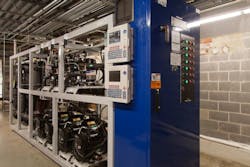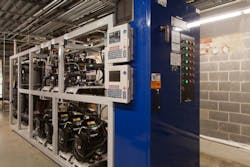REFRIGERATION SERVICE TODAY
Over the past several years, the dynamic regulatory landscape has influenced the selection of commercial refrigeration equipment. Uncertainty about which refrigerants would be available for use — and which would be phased out — has dominated the conversation. In the meantime, operational safety, reliable system performance, total cost of ownership (TCO) and sustainability have become the primary selection criteria.
But with the passing of the American Innovation and Manufacturing (AIM) Act in late 2020, regulatory compliance is again becoming a top priority. The AIM Act brings hydrofluorocarbon (HFC) regulations back into focus at a national level — not just for operators within California and U.S. Climate Alliance states — and promises to end the federal stalemate on the phasedown of HFC refrigerants. And for the commercial refrigeration sector, re-establishing the authority of the Environmental Protection Agency (EPA) to regulate refrigerants will provide much needed regulatory uniformity.
After dealing with years of uncertainty, many organizations have developed refrigerant transition fatigue. Some are seeking a strategy that would remove iterative steps and get them to the end game of compliance. Others prefer to take a more incremental approach, i.e., focusing on a strategy that meets near-term compliance targets but is also capable of adapting to future standards.
Regardless of which approach aligns with your operational objectives, it’s important to be aware of the regulatory implications, available refrigerant options and the refrigeration technologies that enable them.
Understanding the Lay of the Landscape
With the passing of the AIM Act, many industry stakeholders are actively engaged in shaping the regulation with the goals of:
- Supporting the EPA’s renewed HFC phasedown efforts
- Aligning national phasedown schedules with those already defined by certain U.S. states
- Creating a standardized national phasedown approach.
CARB Proposals
In the U.S., California has led the way on the HFC phasedown and has established an ambitious timeline via its California Air Resources Board (CARB) proposals. CARB’s current proposal, which is scheduled to go into effect in Jan. 2022, will include the following rules:
- New facilities — Installation of new refrigeration systems containing more than 50 pounds of refrigerant will be required to use refrigerants with less than 150 global warming potential (GWP).
- Existing facilities — Installation of new systems would be subject to company-wide, fleet GWP reduction targets by 2030 compared to their 2019 baselines. CARB offers two paths to compliance for new systems in existing facilities:
1. Weighted-average GWP (WAGWP) reduction < 1,400 GWP by 2030, where WAGWP is the sum of the total refrigerant charge of every system greater than 50 pounds in every store in California
2. Greenhouse gas emissions potential (GHGp) reduction by 55%, where GHGp is the sum of the total refrigerant charge of every system greater than 50 pounds in every store in California multiplied by the GWP values of the refrigerant types in use.
Not only have CARB’s proposals served as a framework for member states of the U.S. Climate Alliance, they are also influencing the path forged by the AIM Act. For food retailers throughout the U.S., it’s no longer possible to assume that regulations will only impact those operating in California and U.S. Climate Alliance states.
Industry Participates in AIM Act Stewardship
While the AIM Act compliance dates and GWP limits per application are still in the proposal stages, industry stakeholders — such as the Air-Conditioning, Heating, and Refrigeration Institute (AHRI) — are asking that the HFC step-down occurs in two steps over the next five years. Per AHRI’s request:
- Step 1 would begin on Jan. 1, 2022: reducing refrigerant GWP to 1,500 in new remote commercial refrigeration systems > 50 pounds; 2,200 GWP for ≤ 50 pounds.
- Would restore SNAP Rules 20 and 21 standalone, self-contained refrigeration systems, delisting the use of high-GWP HFCs in favor of lower-GWP alternatives.
- Step 2 would take effect in 2026 and require maximum 300 GWP level in new standalone, self-contained refrigeration systems; remote refrigeration systems; and industrial and processing refrigeration (without chillers).
- Would apply to new equipment with a date of manufacture in 2026.
- The selection of a 300 GWP limit — versus CARB’s 150 GWP maximum — would allow a broader portfolio of products to transition to below 300 GWP with available and future alternatives, while preserving energy efficiencies in needed equipment categories.
Following this proposed schedule, new system installations will have to meet reduced GWP levels in the 1,500 range by 2022. And in four to five years, approved refrigerants will likely be limited to those with much lower GWP levels.
Following this proposed schedule, new system installations will have to meet reduced GWP levels in the 1,500 range by 2022. And in four to five years, approved refrigerants will likely be limited to those with much lower GWP levels. With these dates on the horizon, operators should develop a refrigerant transition strategy that accounts for a quickly accelerating HFC phasedown.
Following Kigali Amendment Timelines
The AIM Act directs the EPA to establish HFC production and consumption phasedown limits within the next nine months that are consistent with the Kigali Amendment. These reductions, which are are relative to a 2011–2013 baseline, would include:
- 10% reduction in available supply in 2022
- 40% reduction in available supply in 2024
These phasedowns are expected to not only drive up the price of HFCs but signal the end of a high-GWP HFC era in commercial refrigeration.
Alternative refrigerant options
R-448/449A (low-GWP option)
- GWP: 1,387
- Classification: A1
- Relative GWP reduction: Offers a 65% GWP reduction compared to R-404A (3,922 GWP)
- Recommended uses: Suitable for centralized direct expansion (DX) retrofits and new distributed systems; not to be used as a drop-in replacement
R-407H (low-GWP option)
R-513A (lower-GWP option)
- GWP: 631
- Classification: A1
- Relative GWP reduction: Zero-glide refrigerant delivers a 56% GWP reduction compared to R-134a (1,430 GWP).
- Recommended uses: Frequently used in new distributed systems such as distributed scroll booster; not to be used as a drop-in replacement
A2L and A3 (lower- to lowest-GWP)
- GWP: <300
- Classification: A3 (flammable) aka propane or R-290; A2L (mildly flammable)
- Recommended uses: R-290 is primarily used in self-contained systems with very small refrigerant charges of 150g or less. The safety codes and standards governing their use in commercial refrigeration are being updated to allow potential charge increases.
- Special considerations: A2Ls and A3s may require the approval of local authorities having jurisdiction (AHJ).
CO2 aka R-744 (lowest A1 GWP option)
- GWP: 1
- Classification: Natural
- Recommended uses: Used only in systems designed to handle its high-pressure, low critical point (87.8 °F) and high triple point (-69.8 °F)
- Special considerations: Requires operators to have access to trained CO2 technicians; relatively higher TCO than other alternatives
Strategies for Compliance
While all the details of the current regulatory proposals have not been finalized, it’s clear that many refrigerants in use today will soon not be considered viable options. As the implementation of HFC phasedown regulations may occur in steps over the next five years, operators will likely take one of two approaches to compliance:
1. A phased approach that allows systems to meet an interim, near-term GWP limit, while enabling a retrofit to a lower-GWP refrigerant in future years
2. An end-game approach that meets future-state HFC step-downs by deploying systems with much lower GWP levels
Operators in California will also have the option for a fleet compliance approach that meets CARB’s WAGWP and GHGp calculations.
All these refrigerant transition considerations are impacting system architectures that favor lower refrigerant charges. This will introduce a potential scenario in which operators move from a traditional centralized approach with large refrigerant charges to a more distributed, lower-charge strategy.
Retrofit to R-448A/R-449A in existing centralized DX systems
Replacing R-404A with R-448A will allow operators to achieve sustainability improvements while preserving their existing system investments. Its slightly higher discharge temperatures require additional compressor cooling, such as head cooling fans and/or demand cooling modules, or the installation of a vapor-injected scroll compressor. While this strategy may be viable for fleet compliance, it may not satisfy future low-GWP requirements.
Distributed remote/outdoor condensing units (OCUs)
Designed to service a limited number of medium- (MT) or low-temperature (LT) refrigeration fixtures, OCUs offer installation flexibility and reliability while utilizing low-GWP R-448A today and offering future-state compatibility with A2Ls. OCUs are ideal for small, urban store formats or large supermarkets deploying new refrigeration capabilities outside of their existing DX systems.
Distributed scroll racks
Scroll racks provide operators with a scaled-down, distributed version of a conventional rack system installed in proximity to different refrigerated sections. These systems can utilize R-448A today but also provide future-state compatibility with A2L-compliant products and cases. This distributed strategy allows retailers to significantly reduce their overall refrigerant charge while benefiting from increased system reliability and energy efficiency. In Europe, A2L versions of these systems have already been successfully trialed and deployed.
Micro-distributed (self-contained) units
Flexible stand-alone (aka self-contained) units are ideal for retrofits and remodels. Today, these plug-and-play options are factory-charged with R-290 with a 150g charge limit; potentially larger charges in the future — including A2Ls — would enable even more system capacity. In the near term, these units may also utilize lower-GWP HFCs.
Some equipment manufacturers are designing large self-contained cases that integrate a single compressor, refrigeration circuit and electronic controls within the unit itself. This approach can then be scaled from one to multiple units with all cases connected to a shared water loop to remove heat from the store.
Distributed scroll booster
Another emerging distributed approach utilizes the low-pressure, lower-GWP R-513A for LT and MT circuits in a scroll booster architecture. This system is designed to eliminate the high discharge temperatures and compression ratios typically found in LT systems. Today, distributed scroll booster systems deliver improved energy efficiencies and high reliability within a familiar A1 operating envelope that doesn’t introduce serviceability complexities. This architecture also provides future-state regulatory assurance by offering compatibility with very-low-GWP A2Ls.
CO2 transcritical booster (centralized)
CO2 transcritical booster systems offer an environmentally friendly alternative to HFC-based centralized DX systems. Utilizing R-744 for LT and MT loads, the low-GWP refrigerant allows operators to achieve compliance with future regulations. However, its high-pressure and unique performance characteristics increase system complexities and the TCO. This system strategy is already widely adopted globally and is becoming a more popular system alternative for U.S. retailers, especially with those operating in California or having refrigerant transition fatigue.
Helping Industry in Transition
Today in the U.S., HFC phasedown regulations are still being finalized. But since the AIM Act is aligned with the Kigali Amendment’s phasedown steps and plans to limit HFC refrigerant supplies in the coming years, we can expect the EPA’s sector-based rules to closely resemble current proposals — while balancing the demand side of the equation.
Very soon, operators will have to make decisions that prioritize compliance while weighing other key decision criteria such as safety, TCO, reliability and serviceability.
Emerson is actively participating in stakeholder groups, such as AHRI, to create a path forward that is viable for the entire industry. We are also continuing to develop refrigeration technologies to support any of the approaches discussed herein, and are ready to help operators make the transition to low-GWP, environmentally friendly refrigeration — today and in the future.
Andre Patenaude is responsible for supporting system-related innovation and leveraging Emerson’s global cold chain to drive adoptionAndre has more than 35 years of industry experience in sales, marketing, training and business development of HVACR system architectures and applications with compression and component technologies. He is a certified Mechanical Engineering Technologist C.E.T. (since 1984), and is a member of AHRI, ASHRAE and RSES.


